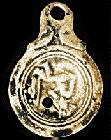Realien: Materialien von Anton Hafner (KZU Bülach)
|
|
Klassische Sprachen |
Quelle:
The Times 13.09.2000 Britain
 |
||
|
|
Woman gladiator found buried in London
BY DALYA ALBERGE, ARTS CORRESPONDENT
TWO THOUSAND years after she embarked on her last fight, the charred remains of a female gladiator have been unearthed in London.
All that is left of her is a pelvic bone, but the accompanying ceramic grave goods at a burial site in Southwark are exciting archaeologists. They include a lamp depicting a fallen gladiator, believed to indicate that the inhabitant was a female gladiator, the first archaeologists have ever known.
Although it was long known that Roman women took to the arena, primarily for the titillation of the spectators, this is the first concrete evidence of female fighters to have emerged.
Speaking at the Museum of London, Jenny Hall, a curator, said: "I have not heard of any other discoveries of female gladiators. In the early stages [of Roman history] sometimes rich women who took a shine to the male gladiators decided to become gladiators themselves, but later the gladiators came from the lower levels of society."
Among eight rare lamps and eight incense burners found is a lamp depicting a fallen gladiator and three others showing images of the Egyptian god Anubis, associated with the passage of the dead to the underworld. Anubis was equated with the Roman god Mercury, and slaves used to dress as Mercury to drag away the fallen bodies of gladiators and others who died in the amphitheatre.
The remains of four chickens, a dove, dates, almonds and figs -
eaten by the mourners, then placed in the burial to accompany the
deceased to the next world - were also discovered, suggesting that
the woman had an exotic and high-status funeral feast in her honour.
Pine cones - an import from the Mediterranean - were burnt as
incense.

Simon Thurley, Director of the Museum of London, said: "The things found with her are things that have not been found before in the UK. That they were found together in that particular combination does seem inextricably to point to the idea of a female gladiator." He added: "We know there were troupes of female gladiators going around; then the whole thing begins to become believable."
Hedley Swain, head of the museum's "early" department, said: "We know that there were female gladiators and they caused a certain amount of controversy. They were very popular for titillating the audience, but were somehow seen as not quite right. They were completely banned in AD200."
He explained: "The position of the objects in the burial point to a rare form of cremation in which the body is burnt over a pyre and is collapsed into a pit."
In Ancient Rome a gladiator - the Latin for "swordsman" (from gladius, "sword") - was a professional combatant. Gladiators originally performed at Etruscan funerals and became during the Empire wildly popular in Rome.
The amphitheatre in which the female gladiator would have appeared was discovered in 1986 underneath the Guildhall and Guildhall Yard. Its capacity was 7,000, for a city whose population totalled 20,000.
The Roman authors Dio Cassius and Tacitus wrote about a show staged by Nero involving female gladiators "that was at once most disgraceful and most shocking". Suetonius reported that Domitian encouraged fights between dwarfs and women, and Juvenal's sixth satire tells the story of a woman of senatorial status who was so sexually attracted to gladiators that she trained as one.
Despite their popularity, female gladiators were viewed as controversial and were eventually banned in AD200 by the Emperor Septimius Severus.
Mr Swain said: "We all have a very familiar image of gladiators as personifying Roman brutality, bloodlust and cruelty. However, there is a more complex form of ideas linked to gladiatorial combat, which had their origin in funeral games." The games also exemplified the way men should die correctly, Mr Swain said. "There is a symbolic and literal link between the games and death . . . Amphitheatres became sacred places and gladiators were seen as having magical properties."
Spice Girls with serious attitude
BY PHILIP HOWARD
THE female gladiator was a novelty but she was not unknown in Rome.
Professional female killers were the Spice Girls of the Ancient World, but they were Spice Girls with attitude and spikes in their hands. They did not mime to the music. When they scored a hit, you stayed hit.
What shocked aristocratic Romans was not the sex of the female gladiators, but their class. A gladiator belonged to an infamis (infamous, untouchable) caste, with a macabre glamour deriving from courage, physical strength and sexual potency, but they were low-life characters. Prisoners-of-war and condemned criminals were compelled to fight in the arena. Professional gladiators were either slaves or free volunteers who bound themselves to an owner by an oath which permitted him to kill or maim them.
The loucher emperors promoted female gladiatorial contests. Under Nero, women of rank "disgraced themselves" in the arena. Domitian had women fighting. His historian seems, however, to find it even more shocking that Domitian staged foot races between maidens.
There is no evidence that the female gladiator wore different kit from the men, except for a primitive armoured bra. In his sixth (anti-female) satire, Juvenal sarcastically describes the equipment of such a female fighter.
She wears a purple tracksuit when resting between bouts. She wears plumes on her head, a baldric (warrior's sword-belt), a thigh-pad for her left leg, and greaves or shin pads. She trains by stabbing at the fencing stump, with her shield well advanced. "Hark how she grunts at each practice thrust, bowed down by the weight of her helmet. See the big coarse puttees wrapped round her ample hands. Then wait for the laugh, when she lays her weapons aside and squats on the potty."
Juvenal asserts that the female gladiator adores male violence, but she would not want to be a man, since his pleasure in sex is so much less.
The British Museum possesses the only relief of two female gladiators. Their names were Amazonia and Achillia. The inscription says that they were given their freedom, presumably for having pleased the crowd.
Upper-class Romans disapproved of female gladiators. The evidence is that everybody else loved them.
Zurück zur Seite "Varia 2000"